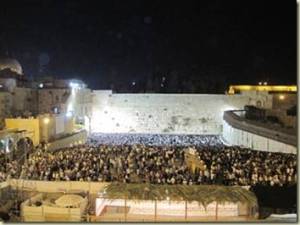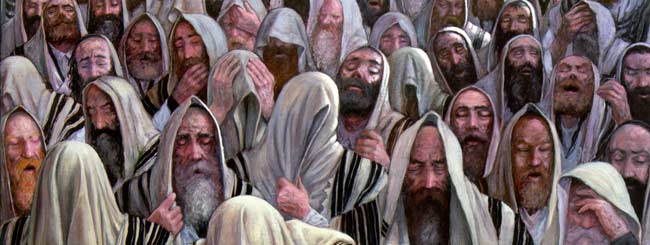No one should feel superior to another person. We are equal in God’s eyes, and we all have sins for which we need to ask forgiveness.
By: Rabbi Ari Enkin, Rabbinic Director, United with Israel
Ten days after the first day of Rosh Hashana is Yom Kippur, the holiest day of the year for the Jewish people. The exclusive themes of the day are atonement and repentance.
The day is observed with an approximate 25-hour period of fasting and intensive prayer, mostly at the synagogue. In addition to being the Day of Atonement, Yom Kippur is the day that Moses received the second set of the Ten Commandments. This signified that the Jewish people were forgiven for the sin of the Golden Calf, hence its designation as the Day of Atonement.
Yom Kippur completes the annual period known in Judaism as the High Holy Days or Yamim Nora’im (Days of Awe), which commences with Rosh Hashana (the New Year). It is also referred to as the “Sabbath of Sabbaths” in Scripture.
According to Jewish tradition, God inscribes each person’s fate for the coming year on Rosh Hashana into a book, either the “Book of Life” or the “Book of Death,” and it is on Yom Kippur that a person’s fate is sealed. Of course, “life” and “death” are not absolutes.
It also refers to the quality of life that a person will enjoy. The days between Rosh Hashana and Yom Kippur are an opportunity to fix our behavior between Man and God as well as between Man and Man.
The Yom Kippur prayer service includes several unique aspects, one of them being the actual number of prayer services. Unlike a regular day, which has three prayer services (Ma’ariv, Shacharit and Mincha) or a Shabbat or festival that includes four prayer services – including the Musaf (literally, added-on) service – Yom Kippur actually has five prayer services: (Ma’ariv, Shacharit, Musaf, Mincha and Ne’ilah – the closing prayer).
Each prayer service on Yom Kippur includes private and public confessions of sins (Vidui). Musaf includes a unique and very elaborate prayer dedicated to the special Yom Kippur service that the High Priest would perform in the Temple. Synagogue attendance soars on Yom Kippur.
Yom Kippur – the Happiest Day of the Jewish Year
Yes, services are very long on Yom Kippur, But don’t think of the services as burdensome. Think of them as an opportunity to re-connect with God and earn forgiveness for all your sins!
The five well-known restrictions observed on Yom Kippur are: no eating and drinking, no wearing of leather shoes, no bathing or washing, no anointing oneself with perfumes or lotions, and no marital relations. Contrary to popular misconception, we don’t observe these restriction due to some kind of sense of mourning or sadness.
In fact, Yom Kippur is the happiest day of the year! It’s the day that God forgives us for all our sins. We observe the restrictions because on Yom Kippur we try to emulate the angels.

Prayers at the Western Wall at 2 am before Yom Kippur last year. (Photo: mpaths.com)
The most well-known prayer of Yom Kippur may very well be the Kol Nidrei prayer, which formally launches the Day of Atonement. It is recited in the synagogue just before sunset. The Holy Ark is opened, and two people remove two Torah scrolls; each one stands on either side of the cantor.
The opening line of Kol Nidrei is fascinating: “In the tribunal of Heaven and in the tribunal of Earth…we declare it permissible to pray with sinners.” This teaches us that no one should feel superior to another person. We are equal in God’s eyes, and we all have sins for which we need to ask forgiveness.
It is customary for married men to wear a kittel on Yom Kippur, a white robe-like garment. The talit, prayer shawl, is also worn on Yom Kippur, as it is each day (by married men, at least), but on Yom Kippur it is worn throughout the entire day – every waking hour, that is. Even those who do not wear a kittel, such as women and single men, should still endeavor to wear as much white as possible on Yom Kippur, as white represents purity. Gold is generally avoided lest it cause God to “remember” the sin of the Golden Calf.
Prayer Services Demonstrate Priority to Rebuild the Holy Temple
A historical review of the Temple service is a major focus in the Yom Kippur prayers. This is based on the Talmudic teaching that by studying the service in the Holy Temple, we are credited as if we had actually performed it.
A number of liturgical poems are recited, the highlight of which is a poem recounting the radiance of the face of the Kohen Gadol, the High Priest, after exiting the Holy of Holies, which was said to emit palpable light in a manner echoing the Torah’s account of the countenance of Moses after descending from Mount Sinai.
There are also many prayers for the speedy rebuilding of the Temple and the restoration of the Temple service.
Yom Kippur War
Yom Kippur, of course, is a legal holiday in the State of Israel. There are no radio or television broadcasts, airports are shut down, there is no public transportation, and all shops and businesses are closed. In 1973, an air-raid siren was sounded on the afternoon of Yom Kippur and radio broadcasts were resumed to alert the public to the surprise attack on Israel by Egypt and Syria that launched the Yom Kippur War.
The day after Yom Kippur is devoted to remembering those who died defending us.
Do You Love Israel? Make a Donation - Show Your Support!
Donate to vital charities that help protect Israeli citizens and inspire millions around the world to support Israel too!
Now more than ever, Israel needs your help to fight and win the war -- including on the battlefield of public opinion.
Antisemitism, anti-Israel bias and boycotts are out of control. Israel's enemies are inciting terror and violence against innocent Israelis and Jews around the world. Help us fight back!
